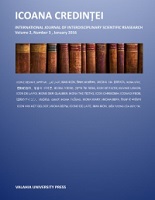BYZANTINE PUBLIC POLICIES: CHARISTIKE
BYZANTINE PUBLIC POLICIES: CHARISTIKE
Author(s): Rodica Elena Soare (Gheorghiu)Subject(s): Economic history, Political history, Social history, Middle Ages, 6th to 12th Centuries
Published by: Ideas Forum International Academic and Scientific Association
Keywords: Charistike; Monasticism; Typikon; Eleventh century; Economy;
Summary/Abstract: The institutional strengthening of monasticism as derived from the iconoclastic period, increased the popular piety towards the monks through that of the upper Byzantine social classes, the civil and military aristocracy and the imperial circle. This led to a substantial increase in the number of monasteries from the ninth to the twelfth centuries. While a good part of these did not last long, new monasteries continued to be erected and the wealth of others increased considerably. Due to the owned land properties, the monasteries became an active part of the Byzantine Empire's economy, imposing the need for regulations and activation of specific economic mechanisms. One of the practices applied to monasteries in the tenth and eleventh centuries is charistike. Its purpose was to assign the monastery to a person, charistikarios, who was obliged to manage it financially, receiving as a benefit, the right to dispose of total income and movable and immovable property of the monastery. This study aims to present aspects of the practice of charistike, and the influence and changes brought on Byzantine society and culture.
Journal: ICOANA CREDINTEI. International Journal of Interdisciplinary Scientific Research
- Issue Year: 8/2022
- Issue No: 16
- Page Range: 37-49
- Page Count: 13
- Language: English

